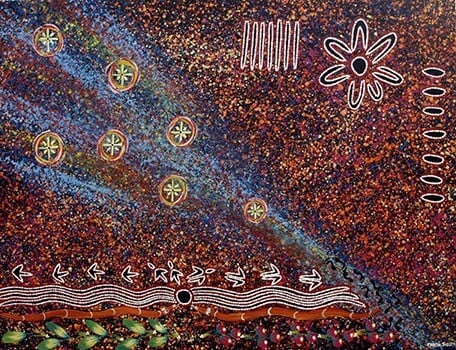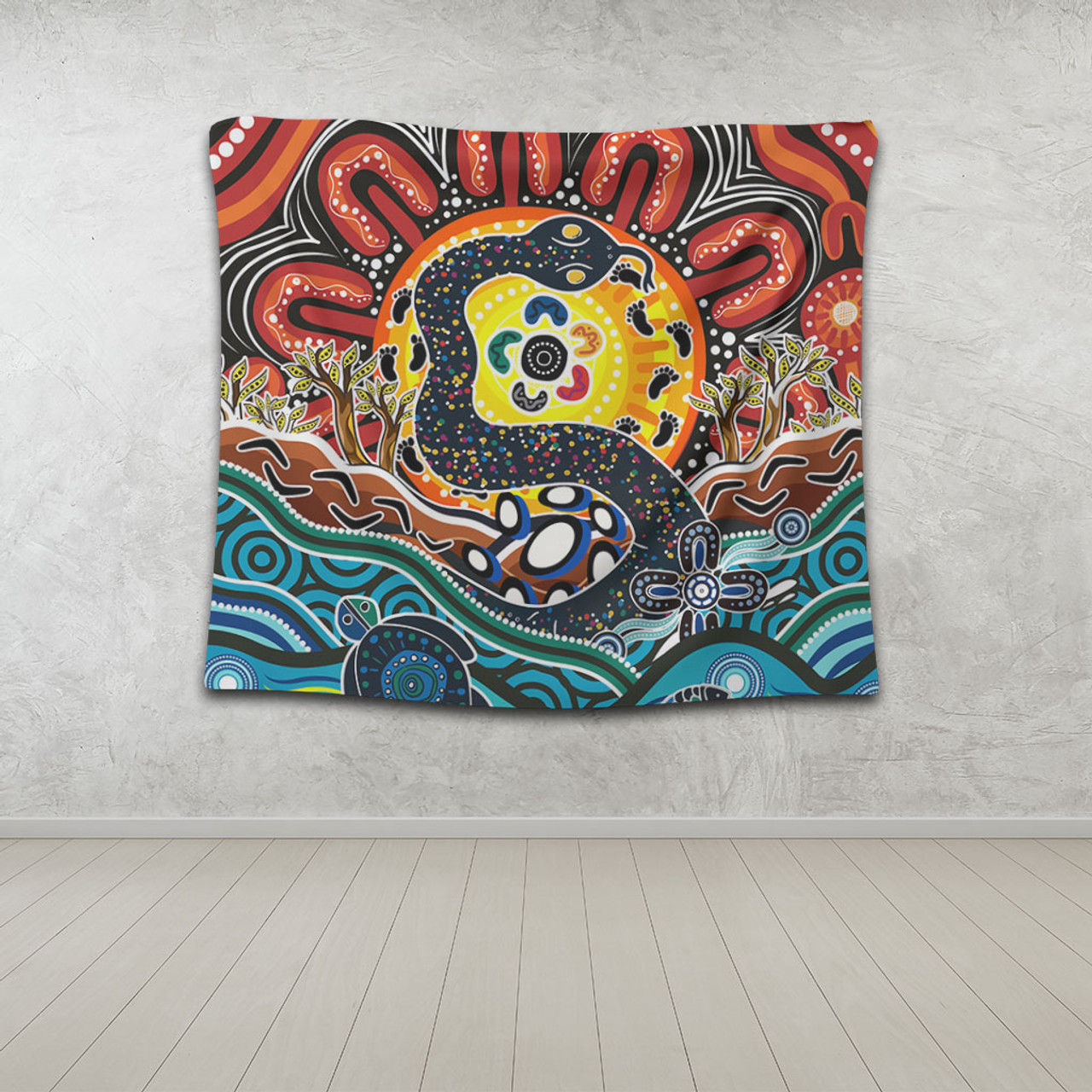Unveiling the Timeless Tapestry: Dreamtime and Its Significance in Aboriginal Art
Unveiling the Timeless Tapestry: Dreamtime and Its Significance in Aboriginal Art

The vibrant, intricate, and often enigmatic world of Aboriginal art holds within it a profound connection to the concept of Dreamtime. More than just a mythical past, Dreamtime is a living, breathing force that permeates every aspect of Aboriginal culture, from their worldview to their art. Understanding Dreamtime is essential to truly appreciating the depth and meaning embedded within Aboriginal art.
Dreamtime: A Journey Beyond Time
Related Articles: Unveiling the Timeless Tapestry: Dreamtime and Its Significance in Aboriginal Art
- Navigating The Outback Of Etiquette: A Guide To Australian Taboos
- The Lingua Franca Of Australia: Exploring The Official Language And Its Rich Linguistic Landscape
- Unveiling The Tapestry Of Time: What Is The Main Dreamtime?
- David Alan’s Native Bees: A Buzzworthy Solution For Your Garden And Beyond
- The Official Language Of Australia: A Comprehensive Guide
Dreamtime, also known as "The Dreaming," is a complex and multifaceted concept that transcends the limitations of time and space. It is not simply a historical event or a distant memory, but rather a continuous, ever-present reality that connects the past, present, and future.
Imagine a realm where the spirit world and the physical world intertwine, where ancestral beings and powerful spirits walked the earth, shaping the land, creating life, and establishing the laws of the universe. This is the essence of Dreamtime. It is a time when the ancestors, in their transformative journeys, created the natural world, its flora, fauna, and the very essence of human existence.
The Ancestral Creators and Their Legacy
Within Dreamtime, ancestral beings, known as "The Dreaming Ancestors," hold a pivotal role. These powerful beings, often depicted in intricate detail in Aboriginal art, are not mere figures of myth but embodiments of the creative forces that brought the world into being. They are the architects of the landscape, the source of life, and the keepers of knowledge and law.
Each ancestral being is associated with specific landforms, animals, plants, and cultural practices. Their journeys and actions during Dreamtime are etched into the very fabric of the land, leaving behind a legacy that continues to shape the lives of Aboriginal people today.
The Importance of Land and Place
Dreamtime is intimately linked to the land. Every rock, river, mountain, and tree holds within it the stories of the ancestral beings who created them. The landscape itself becomes a living testament to Dreamtime, a canvas upon which the stories of creation and law are inscribed.
This deep connection to the land is reflected in the centrality of "country" in Aboriginal culture. Country refers not just to a geographical location but to a complex web of relationships between people, land, and ancestors. It is the inheritance received from the Dreamtime, a responsibility to protect and care for the land and its sacred sites.

The Language of Art: Visualizing Dreamtime
Aboriginal art is a powerful vehicle for communicating the stories and knowledge of Dreamtime. It is a language that transcends words, conveying complex narratives and spiritual beliefs through intricate patterns, symbols, and colors.
The vibrant colors, often derived from natural pigments, represent the energy and spirit of the land. The intricate patterns, often geometric and symbolic, depict the journeys and actions of the ancestral beings. Each element within an artwork, from the composition to the specific motifs used, holds meaning and significance.
The Journey Continues: Dreamtime in Contemporary Art
Dreamtime is not a static concept but a dynamic and evolving force. Contemporary Aboriginal artists continue to draw inspiration from Dreamtime, reinterpreting traditional stories and techniques in new and innovative ways. They use their art to address contemporary issues, such as land rights, social justice, and environmental concerns, while staying true to the core values and knowledge passed down through generations.

Understanding Dreamtime: A Gateway to Deeper Appreciation
By understanding Dreamtime, we gain a deeper appreciation for the richness and complexity of Aboriginal art. It allows us to see beyond the surface beauty of the paintings and tap into the profound spiritual and cultural significance embedded within them. It is a journey of discovery, a chance to connect with a timeless wisdom that continues to shape the lives of Aboriginal people today.
FAQs about Dreamtime and Aboriginal Art
Q: What is the purpose of Aboriginal art?
A: Aboriginal art serves multiple purposes, including:

- Preserving and transmitting cultural knowledge: It acts as a visual record of Dreamtime stories, ancestral journeys, and cultural practices.
- Connecting with the land and ancestors: It strengthens the bond between people and their country, reminding them of their connection to the Dreamtime.
- Expressing spiritual beliefs and values: It provides a visual representation of the sacred beliefs and principles that underpin Aboriginal culture.
- Aesthetic appreciation: It is also valued for its beauty, creativity, and artistry.
Q: What are some common motifs found in Aboriginal art?
A: Some common motifs include:
- Animal figures: Representing ancestral beings, totemic animals, and important creatures in the ecosystem.
- Geometric patterns: Representing the landscape, ancestral journeys, and the interconnectedness of all things.
- Dot paintings: Used for storytelling, representing different elements of the land, and creating visual textures.
- X-ray paintings: Depicting the internal organs and bones of animals, representing their essence and connection to the land.
Q: How can I learn more about Dreamtime?
A: There are many resources available for learning more about Dreamtime, including:
- Visiting museums and art galleries: Many institutions showcase Aboriginal art and provide educational materials on Dreamtime.
- Reading books and articles: There are numerous publications dedicated to Aboriginal art, culture, and Dreamtime.
- Attending workshops and talks: Many Aboriginal artists and educators offer workshops and presentations on Dreamtime and its significance.
- Engaging with Aboriginal communities: Respectful and authentic engagement with Aboriginal communities can provide invaluable insights into Dreamtime and its cultural significance.
Q: Why is it important to respect the cultural significance of Aboriginal art?
A: Aboriginal art is not simply a decorative object but a powerful expression of cultural identity and spiritual belief. It is important to:
- Acknowledge the intellectual property rights of Aboriginal artists: Artworks are not just aesthetic creations but represent a deep connection to the land, ancestors, and cultural knowledge.
- Avoid appropriating or misrepresenting Aboriginal art: It is crucial to respect the cultural context and meaning behind the art and avoid using it for personal gain or in ways that disrespect its significance.
- Support Aboriginal artists and their communities: By purchasing authentic artworks and supporting Aboriginal artists, you contribute to the preservation and continuation of their cultural heritage.
By embracing the profound connection between Dreamtime and Aboriginal art, we can gain a deeper understanding and appreciation for the rich tapestry of Aboriginal culture. It is a journey of discovery that invites us to connect with a timeless wisdom, a vibrant artistic tradition, and a deep respect for the land and its sacred stories.

Closure
Thus, we hope this article has provided valuable insights into Unveiling the Timeless Tapestry: Dreamtime and Its Significance in Aboriginal Art. We hope you find this article informative and beneficial. See you in our next article!


